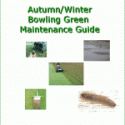It’s nearly time again to be thinking about what to do to the green after the last game has been played.
I still hear the phrases “closing the green down for winter” and “putting the green to bed for winter” all too often and that is a worry.
Of course these are for the most part just harmless terms for the end of the season, but in some cases they still mean literally ignoring the green from now until next March.
Autumn is the only time we can really tackle big issues like thatch reduction and compaction relief in a meaningful way.
We also have to ensure that all running repairs that require re-growth such as over-seeding of bare patches are carried out soon after the season ends to give the work the longest and best chance to succeed.
Moving beyond the autumn renovation plan it is vital that maintenance continues throughout the winter months, especially in terms of compaction relief as this is an ongoing effort and doesn’t stop in winter time. In fact winter is the best time to get on top of compaction by following a concerted monthly program of compaction relied measures.
I’ve updated our Winter Bowling Green Maintenance Guide. The guide is FREE and you can get a copy by dropping your details in the box at the top right of the page.
If you have already signed up to receive email updates from us you will have already received a link to download a new copy.
Good luck with the autumn renovation works and winter programs and remember, if you have any questions just drop me a line anytime.
John


